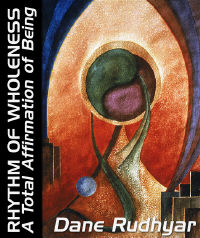 |
| Home | Bio | Art | Music | Literature | Civilization & Culture | Philosophy of Wholeness | Theosophy & Spirituality | Astrology |

RHYTHM OF WHOLENESS A Total Affirmation of Being by Dane Rudhyar, 1983 CONTENTS PROLOGUE PART ONE The Philosophy of Operative Wholeness 1. Prelude to a New Interpretation of Reality 2. The Search for Spiritual Security: The One, the Whole, and Wholeness 3. The Movement of Wholeness PART TWO The Cycle of Being 4. The Structure of the Cycle of Being 5. The Four Crucial Phases of the Cycle of Being 6. The Inevitability of Success and Failure 7. Spirit and Mind PART THREE The Cycle of Man 8. Constitution of Man - The Physical and Psychic Bodies 9. Constitution of Man - The Spiritual Entity and the Higher Mind Page 1 Page 2 10. The Structure and Transformation of the Total Person 11. The Cyclic Process of Spiritual Embodiment PART FOUR In The Spirit of Wholeness 12. The Principle of Holarchy and the Interplay of Horizontal and Vertical Relationships 13. Transpersonal Activity versus Mediumship 14. Rites of Passage EPILOGUE |

CHAPTER NINE
Constitution of Man - The Spiritual Entity and the Higher Mind - 2 In the following I shall attempt to enumerate and briefly describe the main components of a total human being, beginning with the triune spiritual entity, the permanent factor in a series of personalities — the factor that is related to the principle of Unity. In addition I shall refer the reader to the diagram shown in the previous chapter. The spiritual entity in Man is a combination of (1) a universal factor, the power of divine Compassion that is the foundation for all modes of existence; (2) a particular spiritual Quality of being; and (3) a principle of individualization, the function of which is to exteriorize, define, and focus the particular spiritual Quality so it may enter into a one-to-one relationship with a human organism produced in the earth's biosphere. The first factor can be considered simply the reflected light or power of the Godhead state. In this state the principle of Unity reaches the greatest power it can attain in the particular cycle under consideration. But because there are cycles within cycles — a hierarchy of cycles — the degree of inclusiveness and the quality of the Compassion radiating from the Godhead state of any cycle of being is relative to the level the particular cycle occupies in the hierarchy. As there can be no state of absolute Unity, so the character of all-inclusiveness and universality of which we can speak when dealing with the total being of a particular individual is only relative; it is relative to what is possible in the cycle of this individual being who operates within the larger cycle of humanity-as-a-whole, the planet earth, our solar system, and so on. The second factor in the spiritual entity is related to the creative Word of which the spiritual Quality is one single Letter. In another symbolism, this second aspect of the spiritual entity is one "Ray" of the spiritual "Sun" — one of the many Rays or colors of the spectrum of divine Light. Occult traditions speak of primary and secondary Rays, just as other traditions distinguish between Mother-Letters and other Letters in the cosmic Alphabet of being. The third component in the spiritual trinity is related to the Promethean gift bestowed upon Natural Man. It is the principle of individualization, the power of exteriorization required to bring the spiritual Quality to a clearly focalized state. It is closely associated with the "higher mind" needed to formulate — to give an archetypal form — to the spiritual Quality. To focus a spiritual Quality so that it can enter into a one-to-one relationship with a human organism is to "individualize" it. This individualization of the spiritual Quality polarizes the required individualization of the human person, that is, the latter's emergence from the collective psychism of his or her culture. The individualization of spirit requires the operation of the spiritual will, which is the true will; but what most people today call will is the concentrated energy of desire (kama). Spiritual will is "light" rooted in Compassion; the ego-will is "heat" generated by the spasmodic nature of desire. The higher mind gives a steady form to the light of will; the lower mind gives unsteady and often changing forms to the heat of desire. The process of human evolution consists of the transmutation of the fire of desire into the light of Compassion, and of the confused multiplicity of the lower mind's thought processes into the unified revelation — the "seeing whole" — of the illumined mind, the mind of wholeness. The lower mind nevertheless performs an important function during the first phases of the development of human consciousness, when this consciousness emerges from the state of biological (vegetable and animal) consciousness — a state in which it is structured and controlled by instincts. When Natural Man enters the stage of biospheric existence, he is "overshadowed," as it were, by the power of the Godhead released through the primordial Avatar in whom the archetypal Image of Man manifests as a spiritual entity. Both the power of the Godhead and the archetype that gives it a form are almost totally beyond the consciousness of human beings just emerging from the biological state. These emergent human beings are still so close to the animal condition that their minds can operate only as the lower or concretizing mind. The function of this mind is to give concrete form to what makes protohuman organisms human. At that time, "giving concrete form" means expressing the inexpressible and incomprehensible in symbols based on unusual or particularly intense experiences of life in the biological world. The concretizing lower mind thus reflects the realities of the realm of archetypes — the realm of the higher mind — which is then utterly transcendent and ineffable. This, indeed, is what the lower mind always should do. Its function is to translate spiritual realities into life terms, thus into symbols, images, and ritual gestures which become the foundation of cultures uniting and "ensouling" increasingly large groups of human beings. However, the consciousness of primitive human beings is still bound to life energies and instincts operating as rigidly set mechanisms seeking release in fulfilling activities. Therefore, the symbolic forms and magical rites of the culture inevitably are misused and made to serve life desires. Sooner or later, human beings whose biological energies are particularly powerful use the concretizing mind to bring these energies to a sharper, more effective focus. The lower mind then performs two functions: it rigidly maintains the culture's traditional structures and form, and it gives strength to the developing psychism of the community, which usually is dominated by one or more powerful human beings. When the process of individualization begins and culture-wholes are formed whose dharma is to pay particularly focused attention to the archetypal ideal of autonomous and responsible individual selfhood, the concretizing mind gives sociopolitical form to such an ideal. The concepts of democracy, of the "worth and dignity of the individual," of the primacy of the individual over the collective, and of universal reason over particular feelings gradually become official tenets of a new social order. These ideals acquire some kind of religious sanction and eventually are formulated into political laws; but the majority of the people repeatedly and most often successfully circumvent sanctions and laws, often with the tacit approval of priests, prosecutors, and judges. The desires that fill and energize the psychic-astral realm use the lower mind, which has become the servant of the ego. The ego is a psychic structure organized by the concretizing mind, but it is also to some degree a reflection of the principle of individualization within the triune spiritual entity described above. Ideally, the ego reflects this spiritual principle of individualization as the moon reflects the sun. Thus the ego and the other components of the personality over which the ego rules have been called the lunar self, while the triune spiritual entity in archetypal Man has been called the solar Self (or sometimes the Solar Angel). This solar Self and its servant, the higher mind, constitute a fourfold spiritual soul at least potentially active in every human being. It might be related to the Pythagorean Tetraktys (1+2+3+4). The solar Self persists during the entire cycle of Man; it retains its identity, not only through the symbolic Day period of the cycle of being, but also through the Night period. However, when the immense majority of human beings today proclaim, "I am Peter" or "I am Jane," they are not referring to this solar Self. They are at best but vaguely conscious of its existence in the symbolic form given to it by their particular religion or metaphysical group. Rather, when they say "I," they are referring to their personal or lunar self or (psychologically speaking) to their ego. Therefore the next chapter will give a more detailed account of the combination of factors which together constitute the lunar or "lower" self (the personality). Also it will examine the origins of these factors and whither they go when death disassociates them. This picture of what precedes the formation of a personality and will follow its disintegration will pave the way for a discussion of the process popularly known as, reincarnation. The reader may already have surmised that such a process is far more complex than is popularly believed and that the term reincarnation may be misleading. By permission of Leyla Rudhyar Hill Copyright © 1983 by Dane Rudhyar All Rights Reserved.  Web design and all data, text and graphics appearing on this site are protected by US and International Copyright and are not to be reproduced, distributed, circulated, offered for sale, or given away, in any form, by any means, electronic or conventional. See Notices for full copyright statement and conditions of use. Web design copyright © 2000-2004 by Michael R. Meyer. All Rights Reserved. |
 |